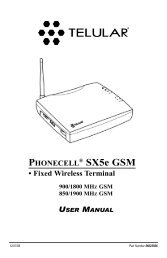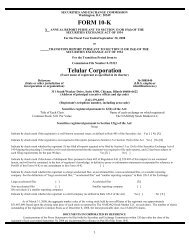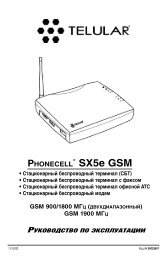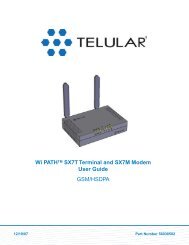Telular Corporation 2001 Annual Report
Telular Corporation 2001 Annual Report
Telular Corporation 2001 Annual Report
- No tags were found...
Create successful ePaper yourself
Turn your PDF publications into a flip-book with our unique Google optimized e-Paper software.
ITEM 7. MANAGEMENT’S DISCUSSIONAND ANALYSIS OF FINANCIAL CONDITIONAND RESULTS OF OPERATIONINTRODUCTIONThe Company designs, develops, manufactures andmarkets products based on its proprietary interface technologies,which provide the capability to bridge standardtelecommunications equipment with wireless communicationnetworks in the Cellular and PCS frequency bands(collectively cellular). Applications of the Company’s technologyinclude cellular fixed wireless telecommunicationsas a primary access service where wireline systems areunavailable, unreliable or uneconomical, as well as cellularbackup systems for wireline telephone systems andcellular wireless security and alarm monitoring signaling.The Company’s principal product lines are: PHONECELL ® ,a line of cellular Fixed Wireless Terminals and cellularFixed Wireless Desktop Phones (collectively FWTs), andTELGUARD ® , a line of cellular wireless security and alarmmonitoring signaling products.Currently, the Company is devoting a substantialportion of its resources to international market development,extension of its core product line to new cellular wirelessstandards, expansion, protection and licensing of itsintellectual property rights and development of underlyingradio technology.The Company’s operating expense levels are based inlarge part on expectations of future revenues. If anticipatedsales in any quarter do not occur as expected, expenditureand inventory levels could be disproportionately high,and the Company’s operating results for that quarter, andpotentially for future quarters, could be adversely affected.Certain factors that could significantly impact expectedresults are described in Cautionary Statements Pursuantto the Securities Litigation Reform Act that is set forth inExhibit 99 to the Company’s Form 10-K.OVERVIEWMajor trends driving the market for the Company’sproducts include a broad consumer acceptance of cellularcommunications, rapid privatization of telecommunicationsin developed and developing countries, adoption of nextgeneration digital wireless transmission standards thatenhance network capacity and service, service networkproviders’ acceptance of cellular FWTs as cost-effectiveanswers to customer demand for basic telecommunicationsand the trend of licensing multiple cellular operators in agiven region, which intensifies competition among cellularwireless service providers to capture additional minutes ofusage and the potential for a large wireline bypass market.Cellular Wireless Local Loop (WLL), which is the coreof the Company’s prospects for the PHONECELL ® businessin developing countries, involves cellular infrastructureemployed predominately (and sometimes exclusively)for the fixed location user. Continued growth of the WLLmarket depends primarily on the pricing of WLL airtimeservice to the customer relative to available wirelineprices, the relative local availability of WLL and wirelineservice, operator regulatory constraints on fixed cellular,and availability of money in a given country. These factorshave contributed to an increase in the number of newcellular networks, primarily in Africa, Brazil, China, India,and Mexico.Wireless Competitive Access, which represents themajority of the Company’s current sales in developedcountries, has evolved as an alternative to existing wirelinesystems, and finds application where wireline service isunavailable, unreliable or uneconomic. FWTs are placedon cellular networks built for mobile cellular phones toprovide regular telephone service. Management anticipatesthat additional cellular FWT markets for wireless alternativeaccess applications will develop as existing cellular networksmature and new networks and high speed data servicesare introduced. As capacity and price competition increaseon new and existing cellular networks and the growth ratein new cellular phone subscribers slows, mobile cellularoperators will be forced to look for new revenue sources.Cellular FWTs provide an excellent opportunity for cellularnetwork operators, as they are less costly to support thanmobile units (because FWTs are permanently linked to aspecific cell site), generate more average airtime, andoperate mainly at off-peak times. The number of cellularFWTs presently operating on these networks is driven bythe relative price for airtime, as well as by the large installedbase of cellular mobile networks worldwide. The Companysees a significant opportunity for growth in developedcountries with the advent of high speed data services.12 TELULAR CORPORATION










